
| Start | Familie en Vrienden | Sport | Racketlon | Jongleren | Reizen | Digi foto's |
| Inleiding | Wetenswaardigheden | Maleisië | Java | Bali | Video's | Foto's |

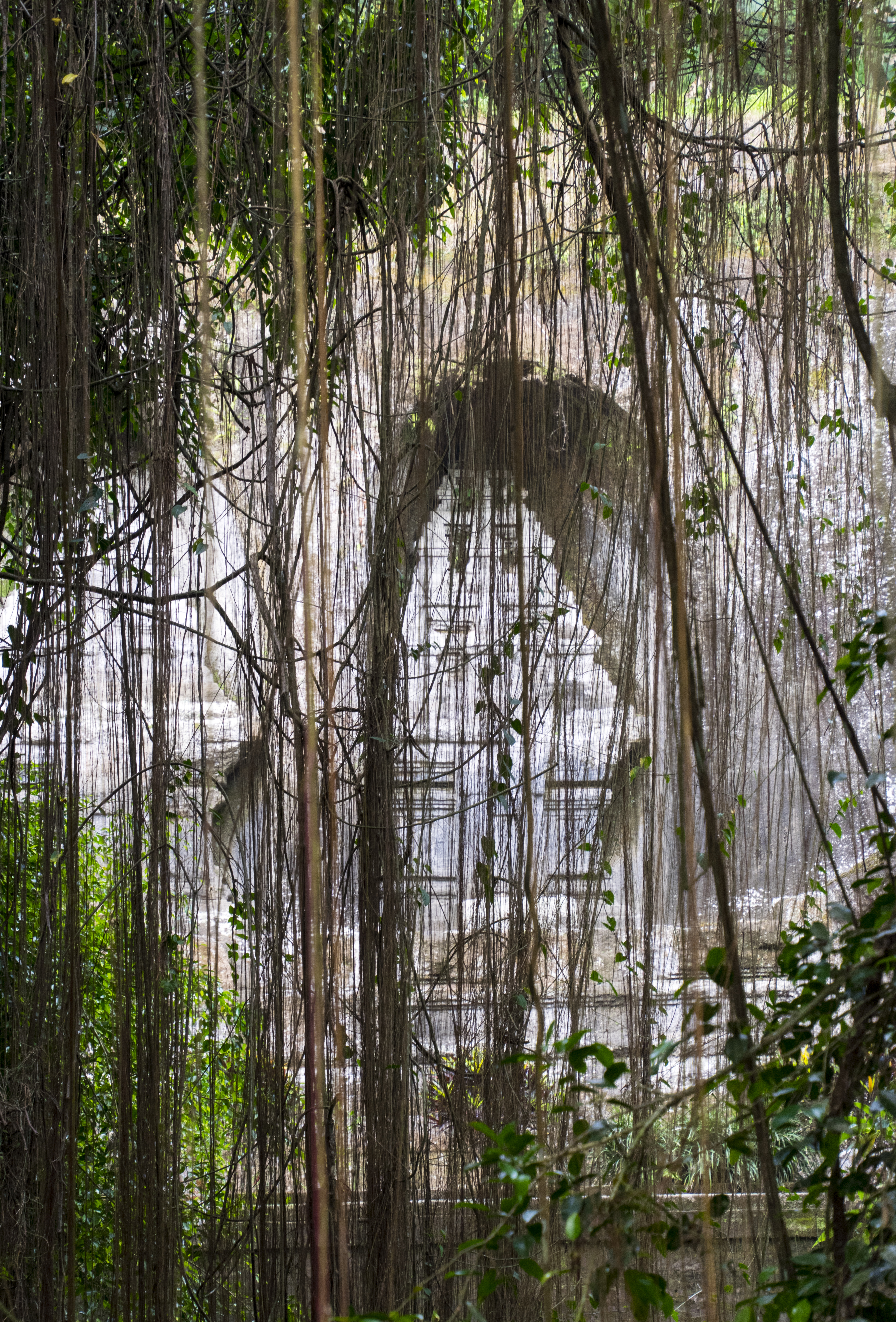 |
Saturday 13th October: Sunday 14th October: after not the best breakfast ever we met our new private driver, same company as Java; Rye (no typo). We headed for the biggest Hindu temple of Bali: Pura Besakih (mother temple). This temple was build 950m height on the slope of the Gunung Agung volcano. It is a large complex containing 3 big and 18 smaller temples, all devoted to the gods Brahma, Shiva and Vishnoe. It is a major Hindi temple, and tourists are requested to stay out of the main temple and wear a sarong so as not to cause too much amok. We were there on a Sunday, a day off for most, and as understood later witnessed a family celebration of which several were ongoing. We circled the center temple and found many similar ones. The most distinguishing in appearance are the split pillars at the gates, where the left and right pillar seem to be cut vertically and separated, allowing one to pass in-between. We have never seen such a temple before and we liked it a lot. We also recognized the machined temple structures made of the volcanic rock abundant in this area. |
|
Bas specially liked the last temple, furthest on the hill, which looked to be the oldest, but may have been made to look like that. It was asymmetrical, had fairy tail castle staircase to the inner yard, then another to the main temple, closed to us. Everywhere you saw a sort of high pole with lots of roofs from tiles or from palm tree material resembling hair, which may be a local or Hindu thing. Every century (the guide book says) a big ceremony is held, with thousands of Hindi attending. During the ceremony of 1963 the Gunung Agung volcano erupted, killed 1500 people. The lava streams hardly touched the temple complex itself, so the gods were thanked for that, as the place must have been cramped and judging by the access roads today, would have taken a while to fill up. Back in the car we learned that every village has 3 temples (for Brahma, Shiva and Vishnoe), and all family’s/houses of stature also have their own 3 temples. When a village was larger it could also contain 6, 9 or more 3-fold temples. Sometimes more temples are found for e.g. ‘good rice harvest’. Indeed it dominates the local architecture (and the abundance of black rock must help). We have lunch in a restaurant which a great view over ricefields in a steep valley and continue our trip to Tirtagangga, the water palace. The name Tirtagangga means ‘holy water from the Ganges’. The complex contains several ponds with tiles to keep your feet dry, surrounded by very big fish (probably so big because tourists are feeding them all day?) and statues in-between. The place is full of tourists, and in line we hop from stone to stone. Walking over the tiles without falling becomes a challenge when crouching or passing another (Bas almost fell in), but many pictures were taken. It is one of the nicest walks in the complex and the most crowded. After this visit we went for a ~1km hike into the rice fields, viewing the clever distribution of water up close. We ended our day back in the hotel in the swimming pool, annexed a roofed platform on the beach, and sipped cocktails there watching the sunset if not reading a book. |

Waterpaleis Tirtagangga |
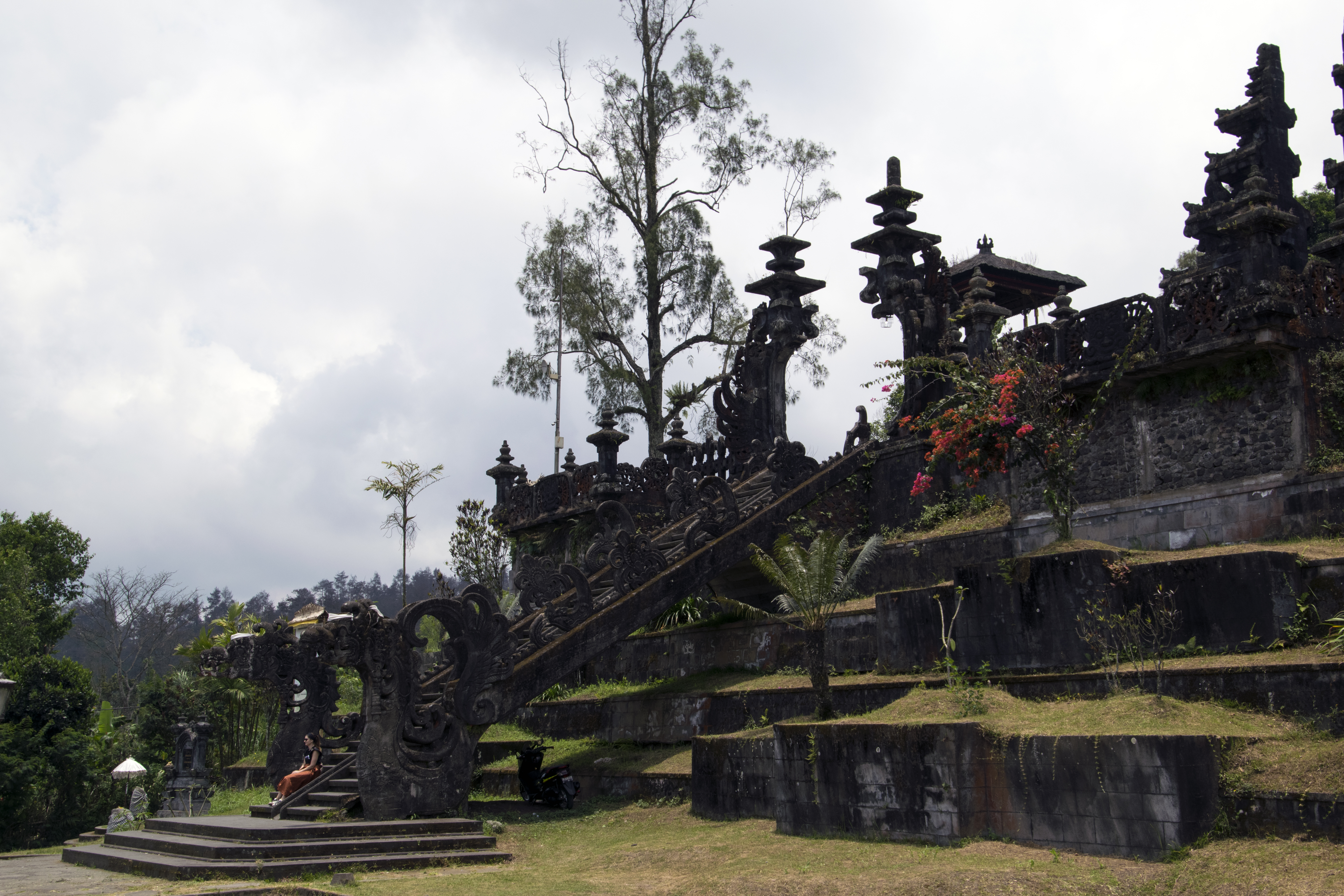 |
Monday 15th October: snorkeling! In a small motorboat with ‘wings on the site’ (zijvleugels) we floated within half a hour to the good snorkeling place blue lagoon. Here, more little boats were anchored. While snorkeling we fed the fish and attracted even more fish. It was a great place. The afternoon we spend reading as this was our relaxing day. Tuesday 16th October: at 8 a.m. we were picked up by our taxi driver Rye. First stop was the volcano Batur. A 3-4km high volcano rose up here and collapsed again roughly 30.000 years ago. It did that twice and a double crater rim of about 10 by 13 km was formed. Since then its center rose up again to a height of 1717m. Next to it more cones, which erupted as recently as 2000, but last spilled lava in the sixties. The access fee to the volcano was a record (and outrageous) 60 euros with mandatory guide to safely see us on and off the top. We had lunch with a view in one of the many places on the rim. Next stop were the elephants. We learned about it a few days earlier and immediately canceled outings to several temples and rice field terraces... We’re sure UNESCO has it right, but we just had to have an elephant ride!! So we did and with us, spread out on its head and employing a pick-axe if need be to get its attention, rode the cutest of elephant tending girls you ever saw. The elephants name was Blue Chip (Loesje) and it carried us for 30 minutes through forest called jungle. Foto: Pura Besakih |
|
The park had deported 27 elephants from Sumatra, and I think this is a slightly larger Asian variety than what we encountered in Laos. Seven bulls and 20 girls, four of the young were bouncing about. To contain them and avoid fights, there were many anchoring spots, rather than cages (though we were wondering if this means that they are tied down most of the day. Our driver told us that this was a good-for-the-elephants park). The elephants were well mannered and easy going and very used to tourists. One of them we passed by during the ride was trashing about in the bathing area and seemed to be enjoying itself immensely. After the ride we could feed the elephants (always hungry) and make photo’s with them. Kirsten saw another couple sitting on the legs of a kneeling elephant and intermediately knew: this photo will be it! It will replace the Australian carpet photo (the hallway carpet of our Groningen house’s first floor is to be entirely made of holiday portraits), which Bas never liked and besides it will also be the introduction photo of our travel website. So, on the advise of our elephant girl we attracted (always hungry) our playful elephant and got the pictures. After this visit, which we’re sure we will remember for a long time, we went to the Gunung Kawi temple. This temple is one of the oldest monuments of Bali (11th century). Nine niches of each 7 meters high have been cut out in the sheer walls of this beautiful valley. Inside, sculpted miniature temples can be seen and it was probably meant as tombs for the royal family, or so says the guide book. We found a couple more than named in the guide book, and especially liked the scenery that was created here. Back in the hotel (always hungry) we ordered a Balinese rice table which contained all sorts of local food and it was one of the best meals of the holiday. Foto: vulkaan Batur |
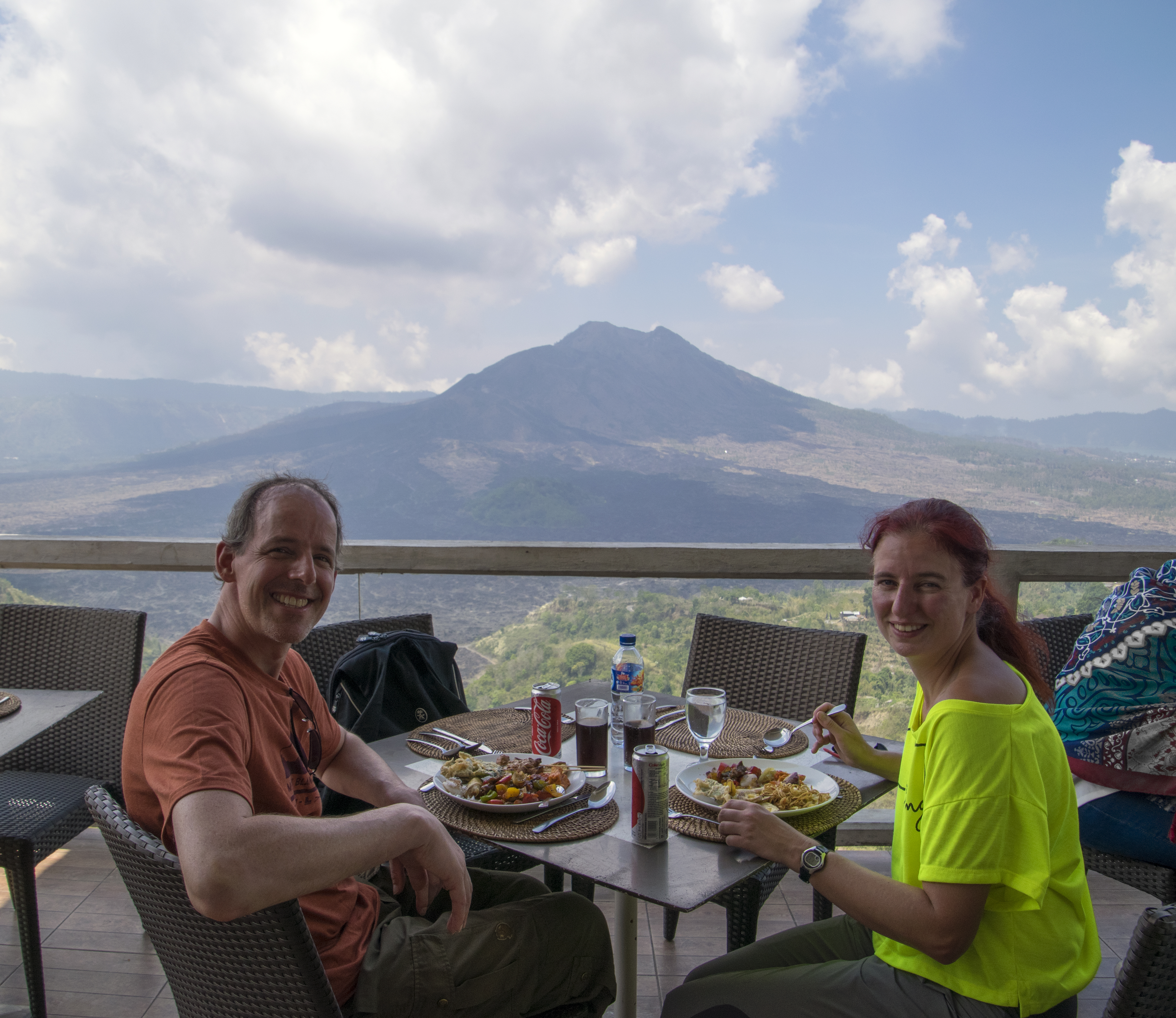
|
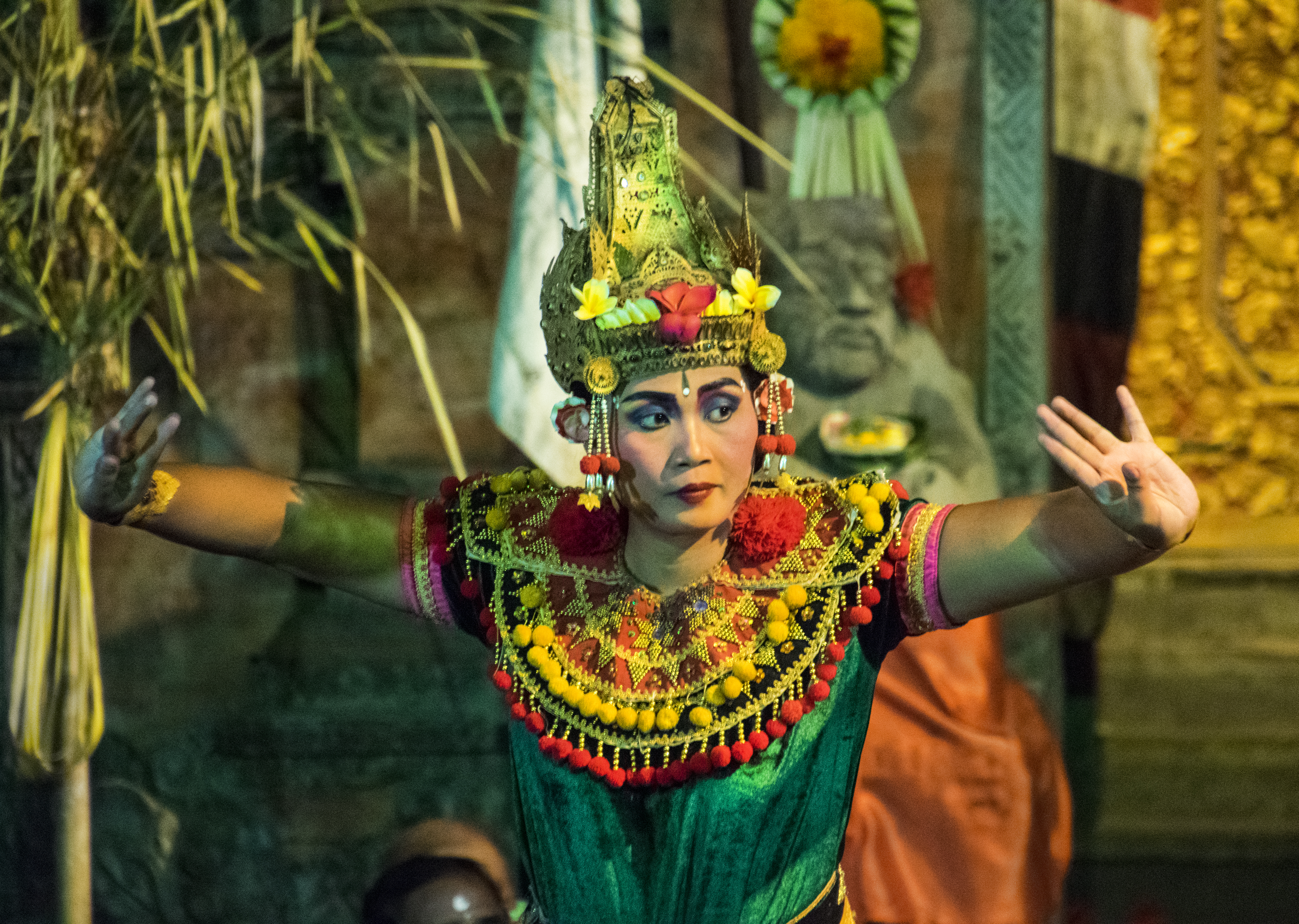 |
Wednesday 17th October: today we had an “Ubud and surroundings day” to look forward to, starting with a small space of rice field terraces set in a steep valley just 20 minutes north of Ubud. The place was crawling with tourists and it seemed to me a trick to keep them together and not spoil the terraces elsewhere so much. We had seen nicer by now, but found a corner with mature plants ready for harvest so we gained that. Also it was fun to see the big swings and picture points they had arranged all about and next to the restaurant we took further down the road Bas made a movie from a girl screaming as she was released out over the valley and couldn’t stop laughing after that. Next stop was the Ubud market. It was huge, though difficult to navigate with multiple stories and unexpected turns. Unfortunately most shops had the same products. Rye had told us that every village had its own temples and suggested to visit a really old one, open for tourists. Having received the sari to wear inside, an attendant stopped all traffic for us so we could cross. We were in blue hour and got some pretty pictures and enjoyed it, though for us it wasn’t remarkable. After sunset we arrived at a theater close to Denpasar. At first we had sheduled a Barong dance, but later decided we have seen enough dancing lions (see travel report Thailand with “het vrolijke achterwerkje”/”the happy little bum”) and switched to the more unique Kecak dance. Though in its current form the dance only exists as of the seventies, it draws on older stories. The leaflet summarized the story, which came in handy. We could actually follow some of it. The unique thing about Kecak is that all music is done by many male vocalists (our show had 30), who contributed to the dance whilst sitting down. The main characters were portrayed by actors in historic costumes, brightly colored, and their dance moves were similar to what we have seen in Laos and Thailand. Kirsten loved the costumes and dance, while Bas enjoyed mostly the vocals. In the car back we talked about the health insurance in Indonesia, which resembled the Dutch system. Also we learned that 50% of Bali’s income is from tourism. |
|
Thursday 18th October: Nusa Lembongan is one of three small islands 12km south of Bali. The original plan was to go back to the main city and then cross the sea. However the city was over an hour away and we had Pandang bay harbor with a shorter crossing nearby, so we took the shortcut. The fast ferry (‘Ameland boot’) dropped us of on docking platform off the coast, and we had to board small boats to get to the shore. There are no passenger docks anywhere on the Island. We wore stickers on our shirts with our destination on it so luckily we could not get lost. The ferry service is door to door so on the beach they made an inventory of hotel destinations then called hotels to board a car. There was some fun there as many tourists did not respond to the local rendition of their hotel name. But then we were inside a vehicle and traversed the small bumby roads to the hotel. Nusa Lembongan is one of the islands not spoiled yet with lots of tourists we heard. No big hotels, 50 years back in time.. Well, the entire Island is one big tourist zone, so unspoiled is not the word. Small scale accommodations are almost anywhere in Bali, so we concluded that ‘50 years back in time’ meant that still nobody had bothered to build a proper passenger dock. So the added value of this island turned out to be zero, but we have some nice reading days to look forward to, and the Island turned out to have some charm. We had a 16-cabin hotel, with ‘hutje bijna aan de zee’, shower and toilet outside again, almost-an-infinity-pool (there was a fence between pool and sea), seaside dinner, overlooking a lagoon filled with small boats. Friday and Saturday 19th -20th October: reading days in and around the swimming pool Foto: snorkelen |
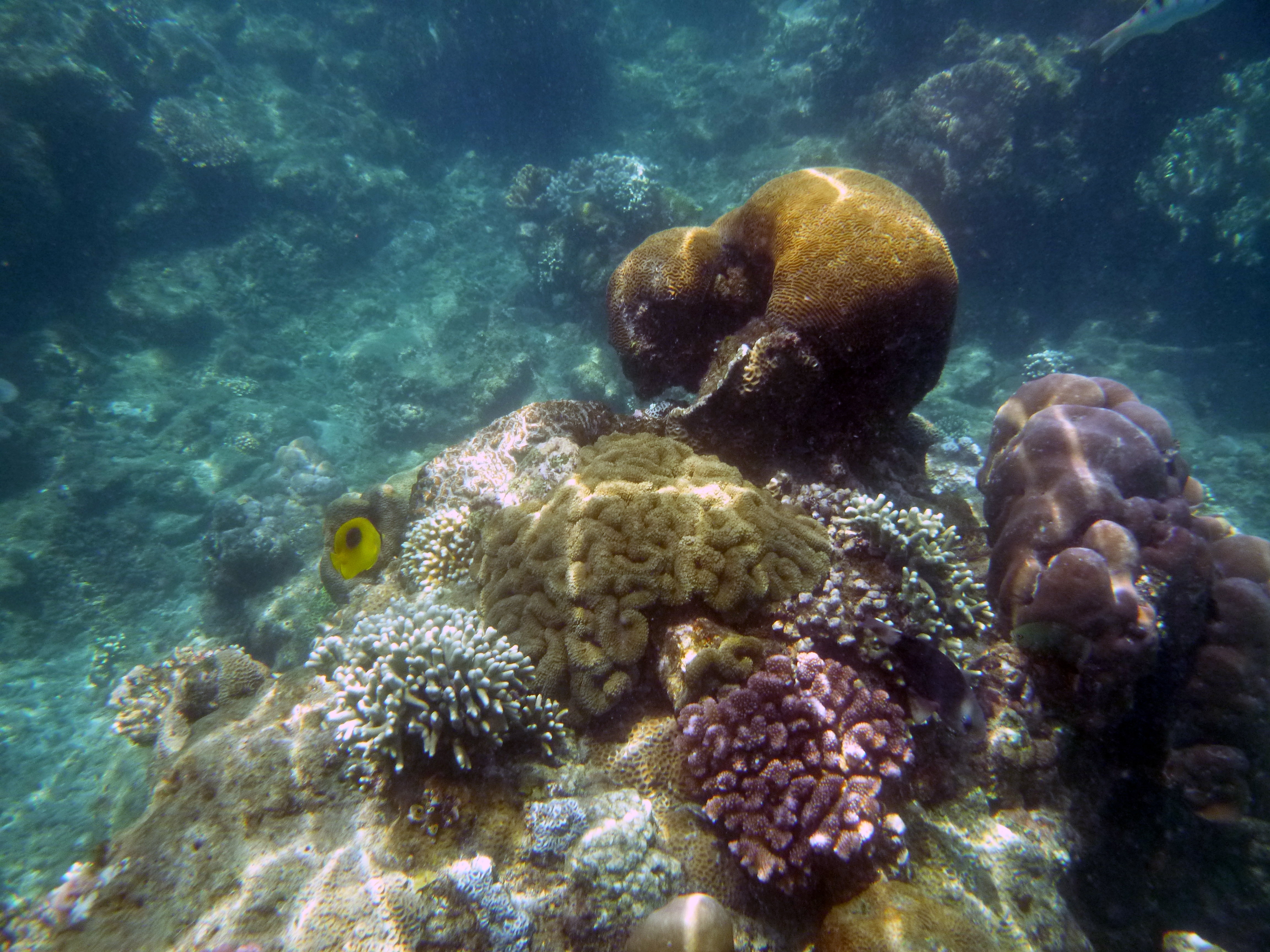 |
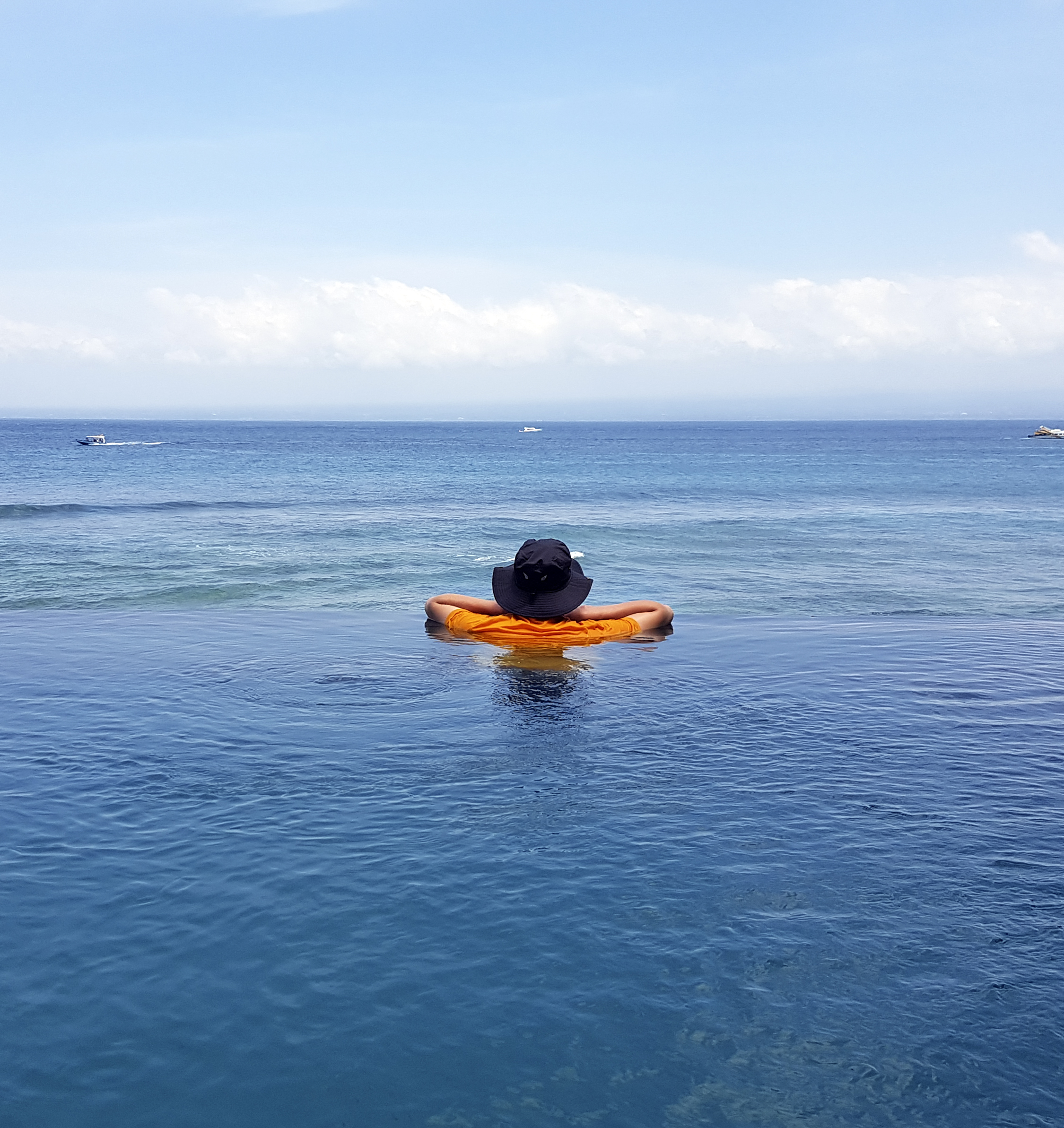 |
Sunday 21th October: in the morning we walked to the nearby Mushroom beach and had drinks in and around its where-else infinity pool. We continued our little hike to another hotel with swimming pool for lunch and discovered that our neighbors had a still better infinity pool though Mushroom beach had the better bay (if the bay is full of boats, you need to fill up the infinity pool with plastic ducks or such to create an infinity effect). Then we found they had the superior cocktails. If a cocktail is a wineglass full of ‘gin, blue curacao and lime’, and nothing else, you can imagine the effect on Bas. To put it another way: Kirsten could have been much further in her book if a certain someone had shut up. Lucky for Kirsten the ‘no-ice’ trick only worked for the first cocktail. For diner we went to a place close to the hotel Kirsten had spotted earlier. When we got there the band was just starting and we picked a seat far from the music, however when shortly after some kind of ridiculously amplified one-man Islamic-sounding opera started we wished we sat closer to the band. He kept it up for 4 hours straight and started again at 7am. Unintelligible, but at least it wasn’t daily. Monday/Tuesday 22th/23th October: after quite a relaxed morning in the hotel and a late checkout, we had a single stop boat back to Bali, Sanur beach, close to Denpasar. It was a canoe compared to the previous ferry, but it was single stop and it did look safe. As expected we had to wade to and off the boat, but 1 hour later, at the airport, we used the ‘repack area’ to wash, repack and switch to comfortable clothes for the flight home. With a stop-over in Singapore we arrived Tuesday morning safely at Schiphol. During the flight out, Bas’ ‘Eiffel tower’ hard-shell suitcase had cracked near a wheel so we won’t be using that one anymore. Really a pity as Kirsten loved it (see 2017 US trip report). Around lunchtime we were sitting on our curry yellow couch, eating crispy Deka crepes cookies (instead of yellow curries). |